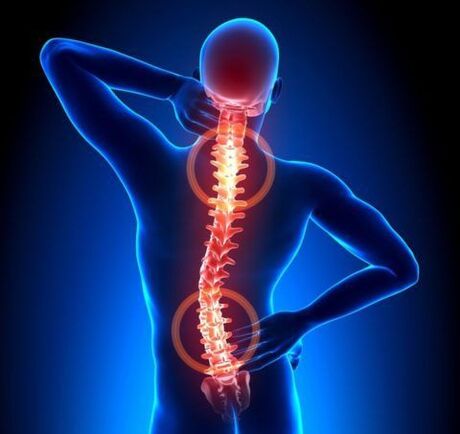
Many people aged 30-35 are complaining about back pain.These pains may be caused by spinal disease.Osteochondrosis is a disease that occurs in the middle, but is often detected in patients after 40 years.
Osteochondrosis - what is this disease and what is the danger?
This term represents the dyspic process of cartilage and bone tissue.In modern medical practice, osteochondrosis is called the degenerative-dynist disease of the spine and intervertebral discs, which plays the role of shock absorber.The risk of the disease is that the affected disc is almost impossible to restore and without proper treatment, disability is possible.
Is osteochondrosis a common disease?The statistics are not happy.The population of the world is approx.85% suffer from this disease.
This disease is the most common form of all diseases that affect the spine.And according to prevalence, it occurs immediately after cardiovascular disease.
The essence of illness
So, osteochondrosis - what is this?It is a chronic disease that affects the joints, most often the spine.
The spinal column consists of 24 vertebrae.There is a plate between the two vertebrae to soften and deprecate the loads.
In normal condition, the disk is quite elastic and is able to withstand significant loads.In the middle of the plate is a paste seed with lots of water.For some reason, the seed loses its hydrophilic properties.
As a result, the disc delays height and deformation.In later stages, bone tissue growth occurs with growth - osteophytes that complain of peripheral nerves and spinal cord.This is what the spine is osteochondrosis.
The causes of pathology
Despite the fact that osteochondrosis is a fairly common disease, the cause of pathology is not fully developed.
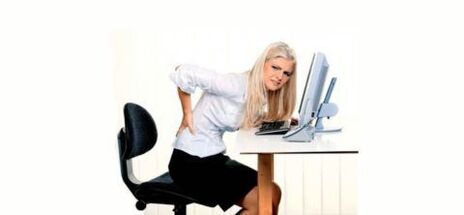
The main factors are taken into account:
- excessive load on the spine;
- injuries;
- Professional damage - weight lifting or longer work in an unpleasant, still pose;
- excess weight;
- heredity;
- A violation of posture.
Osteochondrosis develops at one or another degree in almost every person of the elderly and is a process of body aging.
Stages, forms and symptoms of the disease formation
Experts distinguish between stages of the disease 4:
- Stage 1- Moving the core of the disc on the edge of the disc;
- Section 2- occurrence of cracks in cartilage wheels and instability of the spine;
- Section 3- complete fracture of the plate with the loss of the core in the stem of the spine, while the roots of the spinal cord are possible;
- Stage 4- Rough changes not only on the intervertebral plate but also in the surrounding tissues.
The main symptom of the disease is pain.It can be acute, high intensity or stupid, moderate manifestation.
They are beside the pain:
- painful tension of the back muscles;
- numbness of the skin and legs;
- limiting the amount of movements;
- weakness of the limbs muscles;
- Thinning of arms and legs;
- Sudden dizziness.
These are the general manifestations of all forms of pathology.Depending on the spine, in which the changes are localized, the three forms of the disease differ with typical symptoms.
Table 1.
| The form of illness | Symptoms |
| Osteochondrosis in the neck | Class changes lead to pushing blood vessels and impaired microcirculation.Therefore, one has constant dizziness.Sometimes this leads to fainting.There is no noise in the ears and blinking of colored spots. |
| Osteochondrosis in the chest vertebrae | With this form of disease, acute chest pain can be observed.The disease can cause the advancement of intercostal neuralgia and exacerbate the course of cardiac catologies. |
| Osteochondrosis in the lumbar region | The lower pathology of the back is shown in the gluteal region by a decrease in pain, the IKR sound.The complication can be radiculite, accompanied by pain spreading on the leg. |
Due to the pathology of the spinal cords, there are many disorders in the body: nerve clamping, swelling, circulatory violation and fibrosis of the surrounding tissues.These changes cause various symptoms that complicate the diagnosis and carefully prescribes proper treatment without examination.
Clinical manifestations
The symptoms of the disease depend on where the lesion is located.In the sections below, we take into account the characteristics of the variety of the disease.
The cervix class

The main symptoms of cervical spine damage are as follows:
- discomfort, pain in the neck and shoulders;
- muscle hypotone;
- increased sweating;
- numbness of the fingers;
- violation of coordination of movements;
- headache, dizziness;
- Problems of hearing and vision;
- Hypertension.
One of the following syndromes can develop with the progress of the disease and damage to nearby arteries and nerves:
- spine artery;
- heart;
- hypertension;
- root;
- Cervical migraine.
Violation of blood circulation in the spine artery and brain tissue This hypoxia is a dangerous consequence of osteochondrosis.
This syndrome becomes apparent:
- System/periodic dizziness;
- weakening of vision;
- partial or complete hearing loss;
- Sometimes - fainting.
Important!Neurological manifestations of spinal osteochondrosis must often distinguish between cerebral atherosclerosis, DEP and other pathologies.
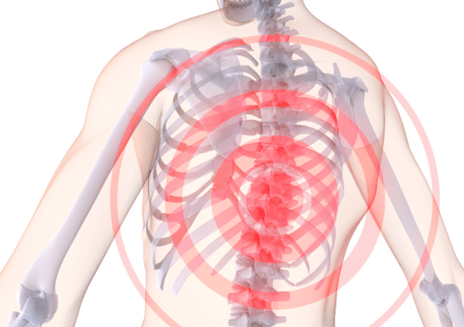
Thoracic
Compared to other forms of the disease, chest osteochondrosis is less explicitly manifested.
Among his symptoms:
- pain in the chest, increases at night or longer in a situation;
- inconvenience, the feeling of pressing between the blades;
- Strengthening pain during deep breathing.
If the disease is not treated, it is progressing, causing damage to nerves near and nearby.
Signs of complications of osteochondrosis of the spine of localization:
- Numbness of the skin in certain areas, feeling of "goosebabumps" climbing;
- Itching and burning of skin;
- cooling of the limbs;
- fragility of the nails;
- pronounced dry skin;
- pain along the esophagus and pharynx;
- Disorders of the stomach tract.
In addition, the disease is characterized by two specific symptoms - dorsago and dorsalgia.
Dorsago is sudden, sharp and very intense chest pain, "chest shift".This may occur if extended in the same position, in monotonous work.
Listen!The pain during the breastfeeding is so severe that patients are afraid of an extra inhalation.
Dorsalgia is less intense but monotonous painful feelings that can last up to 2-3 weeks.They increase with deep breathing and tendencies.
Lumbar class
Osteochondrosis of the lower spine, namely the lower part of the groin, occupies the leading position of prevalence.
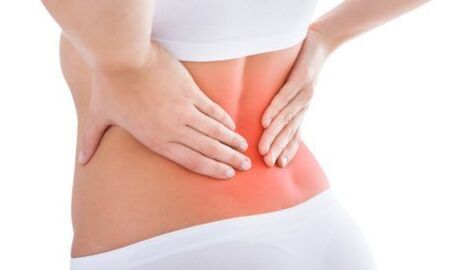
Typical symptoms:
- Boring, more frequently pain in the lower back pain, radiant on the foot;
- discomfort, increasing the body's position, sneezing, coughing, raising weights;
- Constant muscle spasm in the lower back;
- Lamps in the lower back;
- impaired sensitivity to the bottom of the buttocks, hips, legs, legs;
- feeling of goosebamps climbing on the lower limbs;
- Dry skin peeling.
The sacral class
The sacred spine osteochondrosis is isolated in an isolated way and is generally "continued" by lower lumbar damage.
This explains the characteristics of its symptoms:
- lower back pain and sealing nerve;
- Sharp "shelters" through the entire foot;
- feeling of unpleasant discomfort in the back of the thigh;
- Numbness of the lower limb;
- Paresis and unstable symptoms of damaged motor activity.
Important!The lower spine osteochondrosis can lead to extremely dangerous complications such as the blood supply to the spinal cord and compression myelopathy.
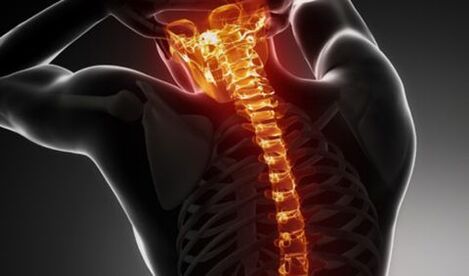
General osteochondrosis
The general form of all parts of the spine or osteochondrosis is the most severe version of pathology.Due to the power of defeat, the image can be extremely varied and contain almost all the symptoms described above.
Diagnostic methods
The appearance of the aforementioned complaints requires an appeal to the medical institution: the patient should examine the patient.Diagnosis of osteochondrosis should be complex and very thorough.
The standard instruction contains the following sections:
- A collection of complaints and anaminesis.
- Clinical control.
- X -Gay test.
- Modern methods (CT, MRI).
Continuing a conversation with the patient, the doctor should know:
- which interferes with the patient;
- What is the place of the most highly highly unpleasant sensations;
- Their intensity and duration;
- which reinforces its strengthening;
- which helps to cope with pain.
Important!It is definitely telling the doctor how long he is worried about such complaints and that he has received treatment earlier.

During clinical control, the specialist assesses:
- position, walking of the patient's body, amount of active and passive movements;
- the presence of skin defects, redness, peeling;
- Symmetry of healthy and sick parts of the body;
- the presence of muscle spasm;
- area of irradiation of pain;
- Presence of pain, temperature and other types of sensitivity.
During the radiography, the spines needed for better display are examined separately.The images are taken directly, lateral and (as indicated).To assess the stage and severity of degenerative-given change, X-ray of osteochondrosis of the Zeaker spine is used.
Table: X -Facials of the spine osteochondrosis:
| Stage | Description |
| I (+) | In a small number of segments, unrelated changes in lordosis |
| II (++) |
|
| III (+++) | Expressive changes, significant narrowing of intervertebral holes |
| IV (++++) | Significant narrowing of intervertebral holes, enormous exostosis, often irreversible changes |
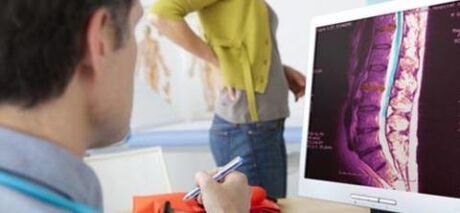
With the inadequate information content of the R image, the patient may prescribe more modern tests (targeted images of one or more segments of the spinal column) and MRI (a visual diagnostic method based on electromagnetic radiation properties).
Treatment
Above all, the doctor explains to the patient what osteochondrosis is and how to treat.He speaks of a set of measures that must be implemented for a long time.
The therapy of the disease is performed, taking into account the stage.During the initial period of the disease, massage, physiotherapy, physiotherapy are indicated.However, as the dystrophic process progresses, various orthopedic tools should be used to immobilize the spine.Drug treatment is also required.
Surgical intervention is indicated by complications and conservative treatment.
Drugs
The most important task of treatment with pharmacological drugs is to relieve pain, eliminate inflammation of the nerve roots, restore the structural ability of the cartilage, improve blood circulation and nutrition, and stop the development of pathology.There are many groups of drugs to prescribe in this case.
Pharmacies are depicted in various forms and diversity.The price of medicines can be different and you can always choose the cheapest.
Table 2.
| Pharmacological group | Therapeutic effect | Instructions for use |
| Chondropotectors | Slowing the degeneration process of cartilage and contributes to recovery. | Take 1 capsule for a month.If necessary, the treatment process is repeated. |
| Nsaid | It has anesthetic effect, reduces the inflammatory process. | Pick up a tablet for pain.In case of severe pain, intramuscular injections of the drug are used. |
| Vitamins B | It improves the conductivity of the nerve impulse and restores microcirculation in the affected cartilage. | The course of treatment with intramuscular injections is performed. |
| Musorelaxants | Relaxing the muscles, relieves tension, facilitates pain. | Take a tablet twice a day. |
Medicines are prescribed according to the doctor's testimony.Mediation on its own can be ineffective and in some cases it can be harmful.
Osteochondrosis physiotherapy
What to do with osteochondrosis except medicines to accelerate healing?Physiotherapy is one of the most effective methods of treating the disease.
The advantage is that it is a selective effect on the focus of the disease.Physiotherapy contributions to reducing pain, eliminating inflammation and increasing general immunity.With their help, the muscles relax, metabolism processes and blood circulation are normalized.
Used successfully for osteochondrosis:
- magnetic therapy;
- laser therapy;
- shock wave therapy;
- quartz;
- electrophoresis;
- Effect of low -frequency electrical currents.
Physiotherapy is not done if the patient is in serious condition, with the worsening of the disease, oncological disease and mental disorder. In other cases, physiotherapy has a beneficial effect on the recovery process and improves the effects of drugs, which reduces their dosage.
In other cases, physiotherapy has a beneficial effect on the recovery process and improves the effects of drugs, which reduces their dosage.
Medical physical education
Physical education classes are prohibited during the acute period of the disease.After abolishing this period, the doctor prescribes therapeutic exercises that he developed with the instructor for each patient.
Exercises help to strengthen the muscle lining, which prevents the curvature of the spine and allows you to distribute the vertebrae correctly and evenly.With regular physical exertion, the medicinal substances penetrate the spine at a higher concentration than in their absence.
You need to control an experienced instructor and carefully monitor their condition.In the event of insufficiency and severe pain, the exercise must be stopped.
Prevention
Knowing what osteochondrosis is and its consequences, it will be useful to think about prevention.
Preventive measures are quite simple, easy to complete for anyone who cares about their health:
- Prevention of injuries;
- Regular physical exercise (swimming is very useful);
- maintains normal weight;
- Do not fill your spine;
- Observe the correctness of posture;
- not to be in a situation for a long time;
- Avoid sudden movements when raising weights.
When these rules are fulfilled, the period of remission will be long.
Osteocondrosis is quite a serious disease.But by searching for doctors and proper treatment, we can stop its destructive effects.
Questions to the doctor
Wearing
Hello, tell me, please.I'm 24 years old.Over the past few months, cervical pain, the back of the head (sometimes it still gives it to whiskey, eyes).I also notice that cervical, tongue and sky in the neck are severe crunching, tingling and numbness.
I suspect osteochondrosis because he was tormented by symptoms similar to both the mother and grandmother.Where do you start the test?And another question: can I go to aerobics?
Make an R-Scheme (CT) shop and the head and neck vessels of the head and neck.He probably developed the spinal arterial syndrome in the background of the cervix osteochondrosis.A further plan for diagnosis and treatment can only be prepared after the test results have been obtained.
It is better not to visit aerobics yet.
Osteochondrosis
For seven years I torture with the lower back, the aggravation of osteochondrosis is almost every 2-3 months.Injections and tablets will help for a short time and then the pain returns.I work as a postman, it becomes harder.Do I do a disability?
Hello!The decision to award a disability group is made by ITU based on a comprehensive study of the situation.First contact the therapist and perform an examination.
As a general rule, in the case of lumbar osteochondrosis, the disability group is not presented.The prize can be improved by developing complications (protrusions, hernia between the vertebrae, etc.).But again, I repeat, all the individual.

























